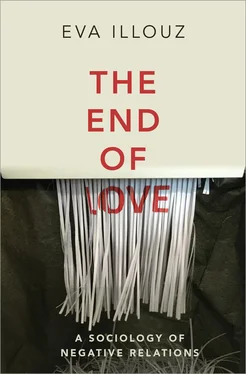21 21. Wendy Brown, States of Injury: Power and Freedom in Late Modernity (Princeton, NJ: Princeton University Press, 1995), 5.
22 22. David Bloor, Knowledge and Social Imagery (London: Routledge & Kegan Paul, 1976).
23 23. Richard Posner, Sex and Reason (Cambridge, MA: Harvard University Press, 1994).
24 24. See Robin West, “Sex, Reason, and a Taste for the Absurd” (Georgetown Public Law and Legal Theory Research Paper No. 11–76, 1993).
25 25. Lila Abu-Lughod, “Do Muslim Women Really Need Saving? Anthropological Reflections on Cultural Relativism and Its Others,” American Anthropologist 104, no. 3 (2002): 783–790, esp. 785; Saba Mahmood, Politics of Piety: The Islamic Revival and the Feminist Subject (Princeton, NJ: Princeton University Press, 2011).
26 26. Michel Foucault, Discipline and Punish: The Birth of the Prison, trans. Alan Sheridan (1975; New York: Pantheon Books, 1977).
27 27. Michel Foucault, Security, Territory, Population: Lectures at the Collège de France 1977–1978, ed. Arnold I. Davidson, trans. Graham Burchell (New York: Palgrave Macmillan, 2007); Michel Foucault, The Government of Self and Others: Lectures at the Collège de France 1982–1983, ed. Arnold I. Davidson, trans. Graham Burchell (New York: Palgrave Macmillan, 2010).
28 28. Nikolas Rose, Inventing Our Selves: Psychology, Power, and Personhood (Cambridge: Cambridge University Press, 1998); Nikolas Rose, Powers of Freedom: Reframing Political Thought (Cambridge: Cambridge University Press, 1999).
29 29. Deborah L. Tolman, Dilemmas of Desire: Teenage Girls Talk about Sexuality (Cambridge, MA: Harvard University Press, 2002), 5–6.
30 30. Quoted in Wendy Brown, States of Injury: Power and Freedom in Late Modernity (Princeton, NJ: Princeton University Press), 20.
31 31. See in particular David M. Halperin and Trevor Hoppe, who document the expansion of sexual rights in the United States in their work The War on Sex. As they document, while there has been progress in marriage equality, reproductive rights, and access to birth control, there remain many areas that are socially controlled by government such as sex offender registries, criminalization of HIV, and punitive measures against sex work. See David M. Halperin and Trevor Hoppe, eds., The War on Sex (Durham, NC: Duke University Press, 2017).
32 32. For an elaborated discussion on this issue, see Dana Kaplan, “Recreational Sexuality, Food, and New Age Spirituality: A Cultural Sociology of Middle-Class Distinctions” (PhD diss., Hebrew University, 2014); Dana Kaplan, “Sexual Liberation and the Creative Class in Israel,” in Introducing the New Sexuality Studies, ed. S. Seidman, N. Fisher, and C. Meeks (2011; London: Routledge, 2016), 363–370; Volker Woltersdorff, “Paradoxes of Precarious Sexualities: Sexual Subcultures under Neo-liberalism,” Cultural Studies 25, no. 2 (2011): 164–182.
33 33. Modern homosexuality constitutes the historical accomplishment of sexual freedom its moral embodiment because, in contrast to Greek homosexuality, it does not organize and naturalize inequality (it is not about the display of power of a man over a slave or a young man).
34 34. Camille Paglia, Sex, Art, and American Culture: Essays (1992; New York: Vintage, 2011, ii).
35 35. Ibid.
36 36. Jeffrey Weeks, Invented Moralities: Sexual Values in an Age of Uncertainty (New York: Columbia University Press, 1995).
37 37. Ibid., 29. The claim, however, is relevant to the Western world, less so to societies like that of China.
38 38. This is, by the way, no less true of homosexual encounters than it is of heterosexual ones.
39 39. Beckert, Jens. Imagined Futures: Fictional Expectations in the Economy. In Theory and Society 42(2), 219–240.
40 40. Leo Tolstoy, War and Peace, trans. George Gibian (1896; New York: W. W. Norton & Company, 1966), 24.
41 41. James Duesenberry, “Comment on ‘An Economic Analysis of Fertility,’” in Mark Granovetter, Demographic and Economic Change in Developed Countries, ed. Universities National Bureau Committee for Economic Research (Princeton, NJ: Princeton University Press, 1985), 233; Mark Granovetter, “Economic Action and Social Structure: The Problem of Embeddedness,” American Journal of Sociology 91, no. 3 (1985): 458–510.
42 42. Sven Hillenkamp, Das Ende der Liebe: Gefühle im Zeitalter unendlicher Freiheit. (Stuttgart: Klett-Cotta, 2010); Anthony Giddens, Modernity and Self-identity: Self and Society in the Late Modern Age (1991; Stanford, CA: Stanford University Press, 2009); Ian Greener, “Towards a History of Choice in UK Health Policy,” Sociology of Health and Illness 31, no. 3 (2009): 309–324; Renata Salecl, “Society of Choice,” Differences 20, no. 1 (2009): 157–180; Renata Salecl, “Self in Times of Tyranny of Choice,” FKW//Zeitschrift für Geschlechterforschung und visuelle Kultur, no. 50 (2010): 10–23; Renata Salecl, The Tyranny of Choice (London: Profile Books, 2011).
43 43. Stephenie Meyer, “Frequently Asked Questions: Breaking Dawn,” accessed September 11, 2016, http://stepheniemeyer.com/the-books/breaking-dawn/frequently-asked-questions-breaking-dawn/.
44 44. Renata Salecl, “Society of Choice,” Differences 20, no. 1 (2009): 157–180; Renata Salecl, “Self in Times of Tyranny of Choice,” FKW//Zeitschrift für Geschlechterforschung und visuelle Kultur, no. 50 (2010); Renata Salecl, The Tyranny of Choice (London: Profile Books, 2011).
45 45. Durkheim, Suicide.
46 46. Günther Anders, “The Pathology of Freedom: An Essay on Non-identification,” trans. Katharine Wolfe, Deleuze Studies 3, no. 2 (2009): 278–310. See also Eric S. Nelson, “Against Liberty: Adorno, Levinas and the Pathologies of Freedom,” Theoria 59, no. 131 (2012): 64–83.
47 47. See Manuel Castells, “The Net and the Self: Working Notes for a Critical Theory of the Informational Society,” Critique of Anthropology 16, no. 1 (1996): 9–38.
48 48. Eva Illouz, Why Love Hurts (Cambridge: Polity Press, 2012).
49 49. See Wolfgang Streeck, “How to Study Contemporary Capitalism?” European Journal of Sociology/Archives Européennes de Sociologie 53, no. 1 (2012): 1–28.
50 50. See, for example, Peter Brooks and Horst Zank, “Loss Averse Behavior,” Journal of Risk and Uncertainty 31, no. 3 (2005): 301–325; Matthew Rabin, “Psychology and Economics,” Journal of Economic Literature 36, no. 1 (1998): 11–46; Colin F. Camerer, “Prospect Theory in the Wild: Evidence from the Field,” in Choices, Values, and Frames, ed. Daniel Kahneman and Amos Tversky (Cambridge: Cambridge University Press, 2000), 288–300.
51 51. “I Don’t,” The Economist, September 1, 2016, http://www.economist.com/news/asia/21706321-most-japanese-want-be-married-are-finding-it-hard-i-dont.
52 52. Fraser, Nancy. 2016. “Contradictions of Capitalism and Care, New Left Review, June–July, pp. 99–117.
53 53. As Daniel Bachman and Akrur Barua describe based on US Census Bureau reports: “Between 1960 and 2014, the median age of first marriage rose to 29.3 years for men and 27.0 years for women from 22.8 years and 20.3 years, respectively.1 During this time, the share of single-person households in total households more than doubled to 27.7 percent and the average number of people per household fell to 2.54 from 3.33.” “Between 1999 and 2014, the number of single-person households went up to about 34.2 million from 26.6 million, an average annual rise of 1.7 percent. Growth in total households during the same period was lower (1.1 percent), leading to a more than 2 percentage point rise in the share of single-person households in total households.” “The projections show that single-person households are set to reach about 41.4 million by 2030, an average annual rise of 1.1 percent over 2015–2030.” US Census Bureau, “Families and Living Arrangements: Marital Status,” October 21, 2015, https://www.census.gov/hhes/families/data/marital.html; US Census Bureau, “Families and Living Arrangements: Households,” October 21, 2015. Ibid. Daniel Bachman and Akrur Barua “Single-person Households: Another Look at the Changing American Family.” (n.p.: Deloitte University Press, 2015), http://dupress.deloitte.com/dup-us-en/economy/behind-the-numbers/single-person-households-and-changing-american-family.html, accessed September 11, 2016.
Читать дальше












